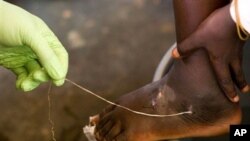As Southern Sudan prepares to emerge on the world stage as the newest nation on the planet, health workers combating Guinea Worm disease are hoping the country’s independence will energize the campaign against the parasite.
The end of Guinea Worm
Its official name is Dracunculiasis. For those stricken, it is a painful experience, particularly when the parasite, also known as Guinea Worm, emerges from the body.
In 1986, more than 3.5 million people in 20 countries were infected with Guinea Worm. That’s when former U.S. President Jimmy Carter and his staff at the Carter Center near Atlanta, Georgia, took on the neglected disease, with the goal of complete eradication.
"Everybody that reads a Bible knows about Guinea Worm. If you read about the Hebrews escaping from Egypt [and] slavery, they were ‘afflicted with the fiery serpent,’ and the ‘fiery serpent’ is Guinea Worm,” Carter explained. “And if you’ve ever seen the symbol for doctors, the Caduceus, with the staff there with things wrapped around it, those are not snakes, they are Guinea Worms. So everybody knows about Guinea Worm, even if you’ve never heard of Dracunculiasis."
The end of Guinea Worm is in sight, thanks in part to the Carter Center’s efforts to show people in remote African villages how to prevent infection by filtering any drinking water that might be contaminated with the parasite larvae.
The efforts paid off in Niger and Nigeria.
Mr. and Mrs. Carter honored both countries at a recent Carter Center ceremony celebrating their successful eradication of Guinea Worm. Nigerian Minister of Health Onyebuchi Chukwu considers the milestone ‘a miracle.’
"What was achieved with the fight against Guinea Worm in Nigeria is nothing short of a miracle. From carrying half of the global Guinea Worm budding in 1988, Nigeria today carries none," Chukwu said.
Eradication almost in sight
Dr. Donald Hopkins, Director of Health Programs at the Carter Center, says with Niger and Nigeria now off the list of countries with Guinea Worm, the rate of new infections is at an all-time low. "As of the end of 2010, we had for the first time less than 2000 cases reported globally of Guinea Worm disease -- 1,797, to be exact,” he said. “Most of those cases -- 1,698 -- were in Southern Sudan."
During Sudan’s civil war, much of the country was off limits to health workers trying to reach affected areas. After several years of relative peace, and now independence in the South, the new country remains one of the most challenging battlegrounds in the fight against Guinea Worm.
"That part of the world has a lot of disadvantages in that it’s poor, it’s a vast area, very little infrastructure, very long rainy season, and we have to fly supplies everywhere, which is very expensive," Dr. Hopkins said.
While there are still active cases of the disease, mostly in Southern Sudan, former president Carter says cross-border transmission is a major concern of U.S. and United Nations health agencies:
Future challenges
"We’ve also found a recent outbreak of Guinea Worm in Chad, which had been completely free of Guinea Worm for more than 10 years. But recently we found a few isolated cases, and now the CDC and WHO are in Chad. So we will be going there to make sure that we can stamp out these re-emerging, small cases of Guinea Worm," Carter stated.
When the new government takes control of Southern Sudan in July, the country will face many challenges. Dr. Hopkins says government officials consider Guinea Worm eradication a priority. “The president of Southern Sudan, Salva Kiir, is very supportive of this effort, and he told President Carter that again this past January during the referendum when President Carter was there, so we are hopeful," he said.
But Dr. Hopkins says any renewed violence or insecurity in Sudan threatens health efforts in the country, and could delay the Carter Center's target date for complete eradication of Guinea Worm, set for 2012.











